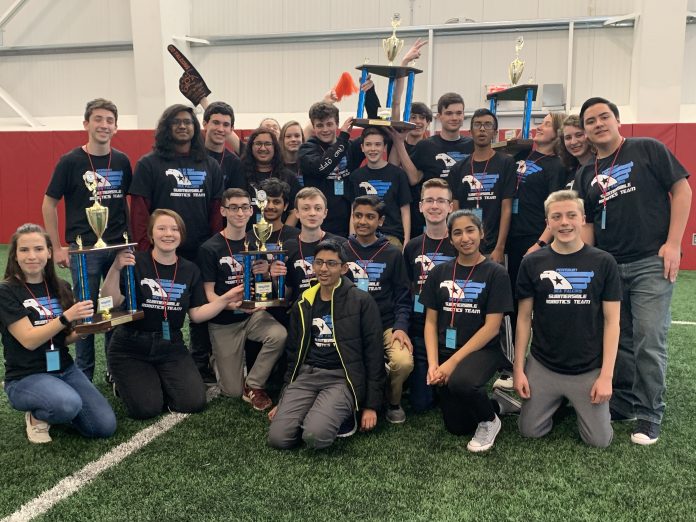The Pennsbury High School SeaFalcons – an underwater robotics club representing the SeaPerch and SeaGlide teams – were hard at work for several months designing and building robots.
It was a lot of work (and countless hours), but the teens’ effort was worth it.
On March 7, at the Greater Philadelphia SeaPerch and SeaGlide Challenge, hosted by the College of Science and Technology at Temple University, the SeaFalcons took home four awards.
In addition to winning the sportsmanship award trophy, the SeaPerch team placed first in vehicle performance and was invited to the 2020 International SeaPerch Challenge at the University of Maryland in May. The SeaGlide team placed first in both best white paper and team presentation/commercial.
“We are so proud of our SeaFalcons. They began the design process in early fall and spent months building and testing their robots. The teams applied science and math principles to tackle specific STEM challenges,” said John Sanders, club adviser and technical education teacher at Pennsbury. “While we are always impressed by our students, we are especially proud that Pennsbury spirit was acknowledged with the sportsmanship award.”
Leading up to the competition, students designed, built and tested robots, prepared team presentations and submitted technical design reports and white papers. Broken into qualifying rounds, pool competitions and formal presentations before judging panels, the Challenge is a full-day event.
At the start of the competition, robots are evaluated during two compliance rounds to verify that the bots meet technical design requirements. Teams who pass the technical portion move to the pool competition.
The SeaPerch and SeaGlide teams participated in separate pool contests.
In order to prepare for the obstacle course and mission pool event, Pennsbury’s SeaPerch team designed a bot composed of pvc pipe, made to travel through two underwater obstacle courses. Following the initial pool competition, the SeaPerch team competed in the “ninja warrior” round as a top-six finisher.
Team pilot CJ Ackler managed the controller, and was supported by Ethan Huegler during the pool competitions.
Pennsbury’s SeaGlide team coded and programmed a self-propelled miniature “glider,” also referred to as an “autonomous underwater vehicle” during the pool rounds. The glider resembled a small bird or airplane in the water, measuring 40 centimeters in length. Pool competition standards required that the glider move half the distance across the width of the pool, and both the speed and accuracy of the bot were factored into the final score.
The SeaFalcons’ glider was managed during the competition by Ansh Shah and Rory Stalter.
In addition to the students mentioned, the SeaPerch team includes Ericka Hansen, Sam Booher, Luke McKeon, Jack Shea, Michael Davis, Vinay Belagodu, Riya Lakhani, Sebastian Godun and Alex Huegler.
The SeaGlide team is Aiden Stein, Miranda Newton, Srujan Kumar Damaraju, Kirti Nagarwal, Adam Steppe, Jacob Katz, April Foster, Ahtesham Alvi, Gabby Podlesney, Tom Cridland, Shivam Patel, Sasha Sahay and Varun Nair.
The event was sponsored by Philly Naval STEM, including the Office of Naval Research and the Atlantic Society of Naval Engineers. Students participated in the competition and STEM activities, and also heard from Capt. Dana Simon, U.S. Navy NSWC Philadelphia Division Commanding Officer. He spoke about the growing need for the Navy to focus on robotics engineering due to the demand for submersible technologies, and encouraged students to consider careers in STEM.
Samantha Bambino can be reached at [email protected]


